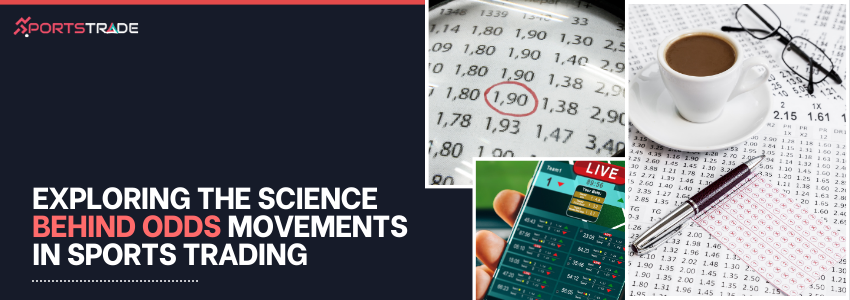Exploring the Science Behind Odds Movements in Sports Trading
- February 17, 2025, by Nandeesh Pandey

Exploring the Science Behind Odds Movements in Sports Trading
Odds movements in sports trading are not random; they are driven by data, market psychology, and external factors. Understanding the science behind these fluctuations can help traders make more informed decisions and improve their profitability. In this article, we’ll explore the key drivers behind odds changes and how to use them to your advantage in sports trading.
1. The Role of Supply and Demand
Like financial markets, sports trading operates on the principles of supply and demand. Odds shift based on the volume of money backing a particular outcome.
How it works:
-
Heavy betting on one side lowers the odds for that outcome while increasing odds for the opposing side.
-
Balanced markets tend to have stable odds, reflecting fair probabilities.
-
Late surges in betting activity can cause last-minute odds swings before an event begins.
Example: If a high percentage of bets favor one team, bookmakers adjust odds to balance liability and ensure profit.
2. Impact of Team News and External Factors
Odds can shift dramatically due to new information that affects a team’s chances of winning.
Key influencers:
-
Injuries and suspensions – Star players being ruled out can significantly alter odds.
-
Weather conditions – Rain, wind, or extreme temperatures can impact game play, particularly in outdoor sports.
-
Managerial changes – A new coach with a strong track record can boost a team’s perceived chances.
Tip: Stay ahead of odds movements by monitoring breaking news before it affects the market.
3. Market Sentiment and Betting Patterns
Public perception plays a crucial role in how odds move, often leading to biases in the market.
How sentiment affects odds:
-
Popular teams attract more bets, leading to shorter odds, even if the value isn’t justified.
-
Recent form perception – A team on a winning streak may be overvalued due to public hype.
-
Underdog appeal – Some bettors favor long shots, causing artificial odds movements.
Example: A big-name football club may have lower odds than statistical models suggest simply because of brand recognition.
4. Real-Time In-Play Adjustments
In live sports trading, odds fluctuate rapidly based on in-game events and market reactions.
Factors influencing in-play odds:
-
Goals and red cards – A goal or player dismissal can instantly reshape market probabilities.
-
Momentum swings – If a team is dominating possession and creating chances, their odds may shorten even before scoring.
-
Time decay – As time runs out in an event, certain outcomes become more or less likely, impacting odds.
Tip: Use real-time data feeds to react quickly to changes and capitalize on fast-moving odds.
5. Sharp Money vs. Public Betting
Professional traders and high-stakes bettors (sharp money) can influence odds significantly compared to casual bettors.
Key differences:
-
Sharp money moves markets based on deep statistical analysis and inside knowledge.
-
Public bets often follow trends, emotions, and media narratives.
-
Bookmakers adjust odds when large amounts of sharp money enter the market to protect their margins.
Example: If odds suddenly drop despite little public attention, it could indicate sharp money influencing the market.
Conclusion
Odds movements in sports trading are driven by a combination of market forces, external news, real-time game events, and betting patterns. By understanding these influences, traders can anticipate changes and make better-informed trades. Ready to trade smarter? Use these insights on SportsTrade and stay ahead of the market!
- Relegation
- Premier League
- Goal Scorers
- Womens Football
- Transfers
- Betting Guide
- Betting Help
- Betting Strategy
- Golden Boot
- Betting Odds
- Sports
- Betting Predictions
- Soccer Betting Tips
- Soccer News
- Betting Tipsters
- Sports Betting
- Soccer Betting
- Player Reviews
- Manager Reviews
- Match Previews
- Match Analysis
- League Reviews
- Club Reviews
- Betting System
- Sports Betting Tips Series
- Esports
- Casino
- Huddersfield Town
- Brighton & Hove Albion F.C
- English Premier League
- Relegation
- Premier League
- Goal Scorers
- Chelsea F.C
- Oliver Giroud
- Transfers
- Norwich City
- FA Cup classic
- Soccer Betting Tips
- Betting 101
- Basic Betting
- SportsTrade
- Golden Boot
- Betting Odds
- Manchester United
- Jose Mourinho
- Ed Woodward
- Boxing
- Rugby
- Sports Betting Tips Marketplace
- Arsenal F.C
- Sir Alex Ferguson
- Betting Method
- Professional Tipsters
- Betting Tips
- Online Sports Betting Tips
- Sports Prediction Tips
- Betting On Sports
- Betting Predictions
- Betting Experts
- Best Football Prediction
- EPL Betting Tips
- Soccer Tipsters Predictions
- Bet On Draw
- Betting Tipster
- Bet On Goal Scorers
- Soccer Tipsters
- Cristiano Ronaldo
- Eric Cantona
- Ryan Giggs
- Paul Scholes
- Peter Schmeichel
- Denis Irwin
- Gary Neville
- Rio Ferdinand
- Nemanja Vidic
- Roy Keane
- David Beckham
- Michael Carrick
- Park Ji-Sung
- Ruud van Nistelrooy
- Wayne Rooney
- Leicester City
- Newcastle United F.C
- Tottenham Hotspur F.C
- Liverpool FC
- Everton F.C
- AC Milan
- Stoke City
- Bull Taming
- Base Jumping
- Heli Skiing
- Harry Kane
- Mohamed Salah
- Sergio Aguero
- Pierre-Emerick Aubameyang
- Romelu Lukaku
- Claude Puel
- Manuel Pellegrini
- Javi Gracia
- Neil Warnock
- Chelsea F.C. Women
- Emma Hayes
- Wolverhampton Wanderers
- Cardiff City
- West Ham United
- Paul Pogba
- Philippe Coutinho
- Barcelona FC
- Alexis Sanchez
- Manchester City
- Money
- Juventus
- Champions League
- Real Madrid
- Neymar
- Hirving Lozano
- Paulo Dybala
- Kylian Mbappe
- Eden Hazard
- Birmingham City Ladies
- Bundesliga
- Bayern Munich
- Borussia Dortmund
- RB Leipzig
- Bayer Leverkusen
- La Liga
- Lionel Messi
- Luis Suarez
- Gareth Bale
- Andre Silva
- Antoine Griezmann
- Luca Modric
- Rapha?l Varane
- Womens Soccer
- Womens Football
- Timo Werner
- Top Scorer
- Robert Lewandowski
- Allison Plea
- Marco Reus
- Vedad Ibisevic
- Serie B
- Switzerland Super League
- Proposition Bets
- Fantasy Premier League
- Forex Trading
- Pep Guardiola
- Lucien Favre
- Thomas Tuchel
- Carlo Ancelotti
- Gareth Southgate
- Marco Silva
- Soccer Betting Market
- Cash Out Betting
- Accumulator Bets
- 1x2
- Total Goals
- Value Bet
- Soccer Betting Jargon
- Bookmaker
- Arbitrage
- Bankroll
- Parlay
- Point Spread
- Gianluigi Donnarumma
- Matthijs de Ligt
- Jadon Sancho
- Vinicius Junior
- Golden Boy
- Barcelona
- El Classico
- World Cup
- La Masia
- AFC Ajax
- Callum Wilson
- Raheem Sterling
- Marcos Alonso
- Andrew Robertson
- Rui Patricio
- Derby
- Manchester Derby
- Derbies
- Merseyside Derby
- Arbitrage Betting
- Betting Strategies
- Match fixing
- Legalisation
- FIFA
- Fernando Torres
- Andy Carroll
- Zlatan Ibrahimovic
- Asian Handicap
- Soccer Predictions
- Team Forms
- Ballon d??Or
- Luka Modric
- Stanley Matthews
- Hedge Betting
- Soccer Betting Lines
- Billy Walters
- KrackMan
- Labouchere
- Betting System
- Reverse Labouchere
- Sportsbook
- Bookies
- Peruvian Primera Division
- Alianza Lima
- Sporting Cristal
- Universitario
- Sport Huancayo
- KF Ferizaj
- Superleague of Kosovo
- Esiliiga
- Veikkausliiga Division
- IFK Mariehamn
- Oeste Futebol Clube
- Fluminense
- Flemingo
- Rot Weiss Ahlen
- Regionalliga
- Professional Punters
- D??Alembert
- Betting Theory
- Fractional Odds
- Decimal Odds
- Sports Betting Legalization
- Sports Betting
- Bitcoin
- Cryptocurrency
- Paroli formula
- Sports Betting Systems
- Positive Progression
- Negative Progression
- Martingale
- Regression analysis
- Fibonacci
- Dalembert strategy
- In-Play
- Goals Bracket
- soccer betting
- Draw Strategies
- Alisson Becker
- Jan Oblak
- Marc-André ter Stegen
- Ederson Santana
- André Onana
- Samir Handanovic
- Hugo Lloris
- Miralem Pjanic
- Kevin de Bruyne
- Christian Eriksen
- Bernardo Silva
- Frenkie de Jong
- Carlos Vela
- Germán Cano
- Abderazak Hamdallah
- Soccer Betting Algorithm
- basics of sports betting
- SMART
- Odds movements
- Vietnam
- Closing Odds
- Money Line
- Betting Line
- Handicap Betting
- Sports Betting In Thailand
- THBookie
- Singapore Pools
- Singapore Turf Club
- Maxbet
- Sbobet
- IMSports
- Sports Bookies
- Kelly Criterion
- Mathematical Method
- Mathematical Methods
- Copa MX
- Rayados de Monterrey
- Xolos de Tijuana
- Betting Strategy
- Betting market
- Double Chance
- Football Predictions
- Betting Forums
- Betting Probability
- Beat The Bookies
- Mathematical Analysis
- Athletic Bilbao
- Real Sociedad
- Copa Del Rey
- Granada
- Sevilla
- Covid-19
- Ekstraklasa
- Legia Warsaw
- Piast Gliwice
- Real Valladolid
- FC Basel
- Swiss Super League
- money management
- Emiliano Buendia
- Atletico de Madrid
- Raul Jimenez
- Adama Traoré
- UEFA Champions League
- Valencia
- Betting Tipsters
- Betting on eSports
- Gambling Industry
- Sportsbooks
- Casino games
- Casino
- Bruno Fernandes
- Jamie Vardy
- Value Betting
- Basketball Betting
- Tennis betting
- D'Alembert
- Fibonacci Succession
- Hits rate
- sports betting programs
- Bet Angel
- X-Bot
- Fairbot
- Sure Bet
- ROI
- Best Money Management Strategy
- Sports Betting Blogs
- Rescuebet
- Insiderbet.tips
- BettorClub
- Zidane
- Martin Odegaard
- Alvaro Odriozola
- EPL
- Transfers Windows
- Chelsea FC
- Takefusa Kubo
- Barcelona Soccer Camp
- Chelsea
- Frank Lampard
- Swansea City
- BTTS
- bankroll management
- Fractional Kelly Criterion
- Serie A
- Benevento
- Crotone
- Spezia
- Lecce
- CAF Champions League
- African Football Confederation
- Ansu Fati
- Roulette
- House Edge
- Poisson Distribution
- Exact Scores
- Ole Gunnar Solskjaer
- Harry Maguire
- Moneyline
- Predictions
- Inter milan
- Roma
- Italian Serie A
- Javier Pastore
- Sbotop
- Sbotop Magazine
- Leeds United Football Club
- Last-Minute Goals
- Value bets
- Todd Cantwell
- Prediction Models
- totalisator
- Tote
- Totalizer Betting
- Mutual Betting
- Joseph Oller
- Under 0.5 Goal
- UEFA
- Europa league
- CSKA Sofia
- Tottenham Hotspur
- Son Heung-Min
- Liverpool
- Jurgen Klopp
- poker
- Texas Holdem
- Omaha Poker
- 7 Card Stud Poker
- 5 Card Draw Poker
- Poker Player
- betting trends
- Profitable trends
- English Championship League
- EFL
- Sky BET Championship
- Krepen Diatta
- Transfermarkt
- Morgan Sanson
- Carlos Fernandez
- Kuaodio Koné
- Ajax
- Eredivisie
- J1 League
- Kawasaki Frontale
- Yokohama M
- AFC Champions League
- FC Barcelona
- Xavi Hernandez
- MLS
- LA Galaxy
- Diego Simeone
- Marcelo Bielsa
- Fibonacci Strategy
- Martingale Strategy
- Ormond betting system
- Bet365
- Blackjack
- New York City FC
- Simon Kjaer
- Fulham
- EFL Championship
- Championship League
- slot machines
- Casino Slots
- Slot Games
- PSG
- French Ligue 1
- Mauricio Pochettino
- Leo Messi
- Spartak Moscow
- CSKA Moscow
- Russian Premier League
- Fortnite
- Kyle Giersdorf
- Bugha
- Martin Satriano
- Nacional de Montevideo
- BTS
- Galatasaray
- Fenerbahce
- Turkish League
- Historic Football Rivalries
- AFC WC Qualifiers
- AFC
- Krakow Derby
- MKS Cracovia
- Wisla Krakow
- Polish Holy War
- Saint-Etienne
- French Ligue 2
- Automate Sports Betting
- Mason Mount
- Portsmouth
- Bonuses
- Betting bonuses
- Bettor
- Dynamo Dresden
- Free Agents
- Franck Kessié
- Marcelo Vieira
- Arturo Vidal
- Hamburger SV
- Werder Bremen
- Nordderby
- Goal Scorer Market
- Over/Under Betting Market
- Scoreline Betting
- Compare Odds
- Head-To-Head
- Losing Streak
- Positive Progressive Betting System
- Progressive Betting System
- Betting On Draw
- Mathematical Betting
- Progressive Betting Strategy
- 2014 World Cup
- 2010 World Cup
- 2006 World Cup
- 2018 World Cup
- Situational Trend
- Technical Trend
- Betting Data Trend
- Betting Bankroll
- Bankroll Management Systems
- Online Betting
- Malaysia Betting Market
- Bookie
- M8bet
- Mathematical Strategies
- Ladder
- Oscar Grind
- Forking
- Hedging
- Flat Betting
- Pre-Season Betting Strategy
- Matched Betting
- Sports Predictions
- Lay Betting
- Back Betting
- Bettors
- Science Betting
- Handicap
- Total Goal
- First Goalscorer
- Advanced Analytics
- Sports Analytics
- Player Valuations
- Spread Betting
- Risk Management
- Technical Analysis
- Live Betting
- Betting Exchange
- Correct Score
- Lay Bet
- Pandemic
- Esports Betting
- Counter-Strike
- Dota
- League of Legends
- Overwatch
- Legality Of Sports Betting
- Gambling Skills
- Betting Psychological
- Psychology Of Sports Predictions
- Statistics And Analytics
- Sports Prediction Model
- Probability Theory
- Line Shopping
- Betting Lines
- Spreads Betting
- Influence Of Weather
- Situational Trends
- PASPA
- Professional and Amateur Sports Protection Act
- Professional Tipster
- Tipster
- Odds Comparison
- Bookmakers
- European Soccer Leagues
- Value Of Trends
- Analyzing Team Form
- Long-Term Performance
- Short-Term Performance
- Transfer Window
- Future Bets
- Clean Sheet Betting
- Clean Sheet
- Betting On Clean Sheet
- Goals Conceded
- Man Marking
- Zone Marking
- Team Chemistry
- Tactical Adjustments
- Market Perception
- Betting Volume
- Legal Framework
- UK Gambling Commission
- Gambling Act
- Advanced Data Analytic
- Data Analytic
- Progressive Betting
- Losing Streaks
- Winning Streaks
- Blockchain
- Soccer Betting Algorithms
- Betting Algorithms
- Statistical Analysis
- Prediction Algorithms
- Early Betting Odds
- Closing Lines
- Betting Portfolio
- Managerial Changes
- Managerial History
- Betting Value
- In-Play Betting
- Pre-Match Bet
- Livestream
- Implied Volatility
- Sports Trading
- Ticks Technique
- Scratching Technique
- Scalping Strategies
- Green Up Technique
- Hedging Technique
- Data Analytics
- Sports Trader
- Sports Trading Union
- Risk Tolerance
- Coherence
- Coherence The Philosophical
- Sports Betting System
- Arsenal
- xG Statistic
- xG
- Expected Goals
- Mix Parlay
- Underdog
- Cashout
- 3-Way Handicap
- Situational Stats
- Football Betting Odds
- Decimal
- Paroli
- Statistical Models
- Data Analysis
- Betting Formula
- Liverpool Football Club
- Heysel Stadium
- Luton Town
- Oxford United
- Patrick Vieira
- Gianluca Zambrotta
- Bayern Munich Football Club
- Barcelona Football Club
- Cruyff Era
- Paris Saint Germain Football Club
- Paris Saint Germain
- Newcastle United Football Club
- Newcastle United
- Mike Ashley
- No Deposit Bonuses
- Cryptocurrency Betting
- Betting Marketing
- Sizing Strategies
- Statistical Software
- Betting Markets
- Sports Betting Odds
- Implied Probability
- Expected Value
- Wewin
- Market Trends
- Live Sports Trading
- Stop-Loss Strategy
- Winning Trades
- Live Data
- Liquidity
- Odds Movement
- Betting Data
- Betting Edge
- Predictive Analytic
- Monte Carlo




